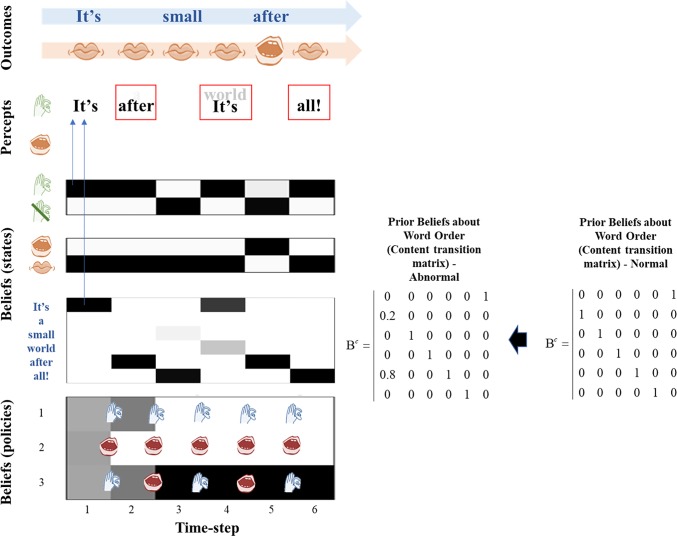Fig 5. Out-of-context hallucinations.
In this figure, the agent has been equipped with an anomalous transition matrix as well as a reduced likelihood precision. The anomalous transition matrix is presented alongside the figure, in comparison to the normal matrix employed in experiment 2. In this case, the agent again experiences hallucinations at the 2nd, 4th, and 6th time steps but these are ‘out of context’ or out of the usual order of the song at the 2nd and 4th timesteps. Here the agent has heard “after” at the second time step instead of “a”, and “It’s” at the 4th time step instead of “world”. It also fails to hear the other agent (the generative process) at the 3rd time step, and believes “all!” should be present instead of “small”. It fails to hear its own voice at the 5th timestep. Here, lighter colored font indicates a lower certainty that word is being heard, and darker font a higher certainty. As an example of how an out-of-context hallucination emerges, going into the 2nd timestep the agent samples a “listening” action, from policy 1 or 3. This induces a prior belief that it will be hearing something at timestep 2, even though no sound is present at this time. The low likelihood precision leads it to hallucinate–as it cannot use the silence to correct this prior belief. As the anomalous transition matrix is in play, the agent hears “after” instead of “a”, because it is unable to use the lexical cues to predict the correct word order. The critical point of this figure is that anomalous posterior beliefs about content only emerge in the context of a low likelihood precision- the agent in experiment 3 has the same anomalous transition matrix (prior beliefs) as the agent in this experiment, but has normal posterior beliefs about content because it is able to cue into its environmental partner, demonstrating that out-of-context hallucinations are not caused solely by having fixed false prior beliefs. As in the previous figure, Bayesian smoothing is in play which allows the agent to have beliefs about the correct song order at the 2nd and 4th time steps.

